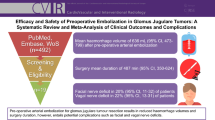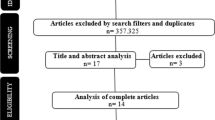Abstract
Purpose
To evaluate the efficacy and safety of endovascular therapy in oral hemorrhage from malignant head and neck tumors.
Methods
Ten patients (mean age 56 years) with oral hemorrhage caused by malignant head and neck tumors underwent a total of 13 emergency embolization procedures using gelatin sponge particles, steel and/or platinum coils, or a combination of these embolic materials. Angiographic abnormalities, technical success rate, clinical success rate, recurrence rate, complications, hemostatic period, hospital days, survival days, and patient outcome were all analyzed.
Results
Angiographic abnormalities were identified during 85% of procedures (11/13). The technical success rate was 100% (13/13 procedures). The primary and secondary clinical success rates were 77% (10/13 procedures) and 67% (2/3 procedures), respectively. The overall clinical success rate was 92%, and the recurrence rate was 22% (2/9 procedures) in patients whom we were able to observe during the 1-month period after embolization. No major complications occurred. Several patients in whom gelatin sponge particles had been used complained of transient local pain after the procedure. The median hemostatic period was 71 days (range 0–518 days). Median hospital and survival days were 59 days (range 3–209 days) and 141 days (range 4–518 days), respectively. Three patients survived and 7 patients died during the observation period. Only 1 of these 7 patients died from hemorrhage.
Conclusion
In conclusion, our findings suggest that endovascular therapy is an effective, safe, and repeatable treatment for oral hemorrhage caused by malignant head and neck tumors.




Similar content being viewed by others
References
Diaz-Daza O, Arraiza FJ, Barkley JM, et al (2003) Endovascular therapy of traumatic vascular lesions of the head and neck. Cardiovasc Intervent Radiol 26:213–221
Luo CB, Chang FC, Teng MM, et al (2003) Endovascular treatment of the carotid artery rupture with massive hemorrhage. J Chin Med Assoc 66:140–147
Larsen DW (2002) Traumatic vascular injury and their management. Neuroimaging Clin North Am 12:149–269
Bates MC, Shamsham FM (2003) Endovascular management of impending carotid rupture in a patient with advanced head and neck cancer. J Endovasc Ther 10:54–57
Sittel C, Gossmann A, Jungehülsing M, et al (2001) Superselective embolization as palliative treatment of recurrent hemorrhage in advanced carcinoma of the head and neck. Ann Otol Rhinol Laryngol 110:1126–1128
Feifel H, Volle E, Riediger D, et al (1991) Superselective embolization in an erosive haemorrhage of a carcinoma in the parotid gland. Int J Oral Maxillofac Surg 20:369–370
Masuda G, Nagamori T, Kawabe R, et al (1989) Utilization of therapeutic embolization in haemorrhage caused by carcinoma of the tongue. J Craniomaxillofac Surg 17:323–325
Bhansali S, Wilner H, Jacobs JR (1986) Arterial embolization for control bleeding in advanced head and neck carcinoma. J Laryngol Otol 100:1289–1293
Griska LB, Aghamohamadi AM, Marlowe LI, et al (1981) Embolization of hemorrhage caused by carcinoma of the pharynx. Head Neck Surg 3:202–203
Remonda L, Schroth G, Caversaccio M, et al (2000) Endovascular treatment of acute and subacute hemorrhage in the head and neck. Arch Otolaryngol Head Neck Surg 126:1255–1262
Mok JS, Marshall JN, Chan M, et al (1999) Percutaneous embolization to control intractable in nasopharyngeal carcinoma. Head Neck 21:211–216
Morrissey DD, Andersen PE, Nesbit GM, et al (1997) Endovascular management of hemorrhage in patients with head and neck cancer. Arch Otolaryngol Head Neck Surg 123:15–19
Wilner HI, Lazo A, Metes JJ, et al (1987) Embolization in cataclysmal hemorrhage caused by squamous cell carcinomas of the head and neck. Radiology 163:759–762
Zimmerman RA, Mclean G, Freiman D, et al (1979) The diagnostic and therapeutic role of angiography in lingual arterial bleeding. Radiology 133:639–643
Rady MY, Nightingale P, Little RA, et al (1992) Shock index: A re-evaluation in acute circulatory failure. Resuscitation 23:227–234
Razack MS, Sako K (1982) Carotid artery hemorrhage and ligation in head and neck cancer. J Surg Oncol 19:189–192
Berenstein A, Kricheff II (1979) Catheter and material selection for transarterial embolization: Technical considerations. II Materials. Radiology 132:631–639
Kunstlinger F, Brunelle F, Chaumont P, et al (1981) Vascular occlusive agents. AJR Am J Roentgenol 136:151–156
Barth KH, Strandberg JD, White RI Jr (1977) Long term follow-up of transcatheter embolization with autologous clot, oxycel and gelfoam in domestic swine. Invest Radiol 12:273–280
Berenstein A, Kricheff II (1981) Microembolization techniques of vascular occlusion: Radiologic, pathologic, and clinical correlation. AJNR Am J Neuroradiol 2:261–267
Author information
Authors and Affiliations
Corresponding author
Rights and permissions
About this article
Cite this article
Kakizawa, H., Toyota, N., Naito, A. et al. Endovascular Therapy for Management of Oral Hemorrhage in Malignant Head and Neck Tumors. Cardiovasc Intervent Radiol 28, 722–729 (2005). https://doi.org/10.1007/s00270-004-0130-5
Published:
Issue Date:
DOI: https://doi.org/10.1007/s00270-004-0130-5




